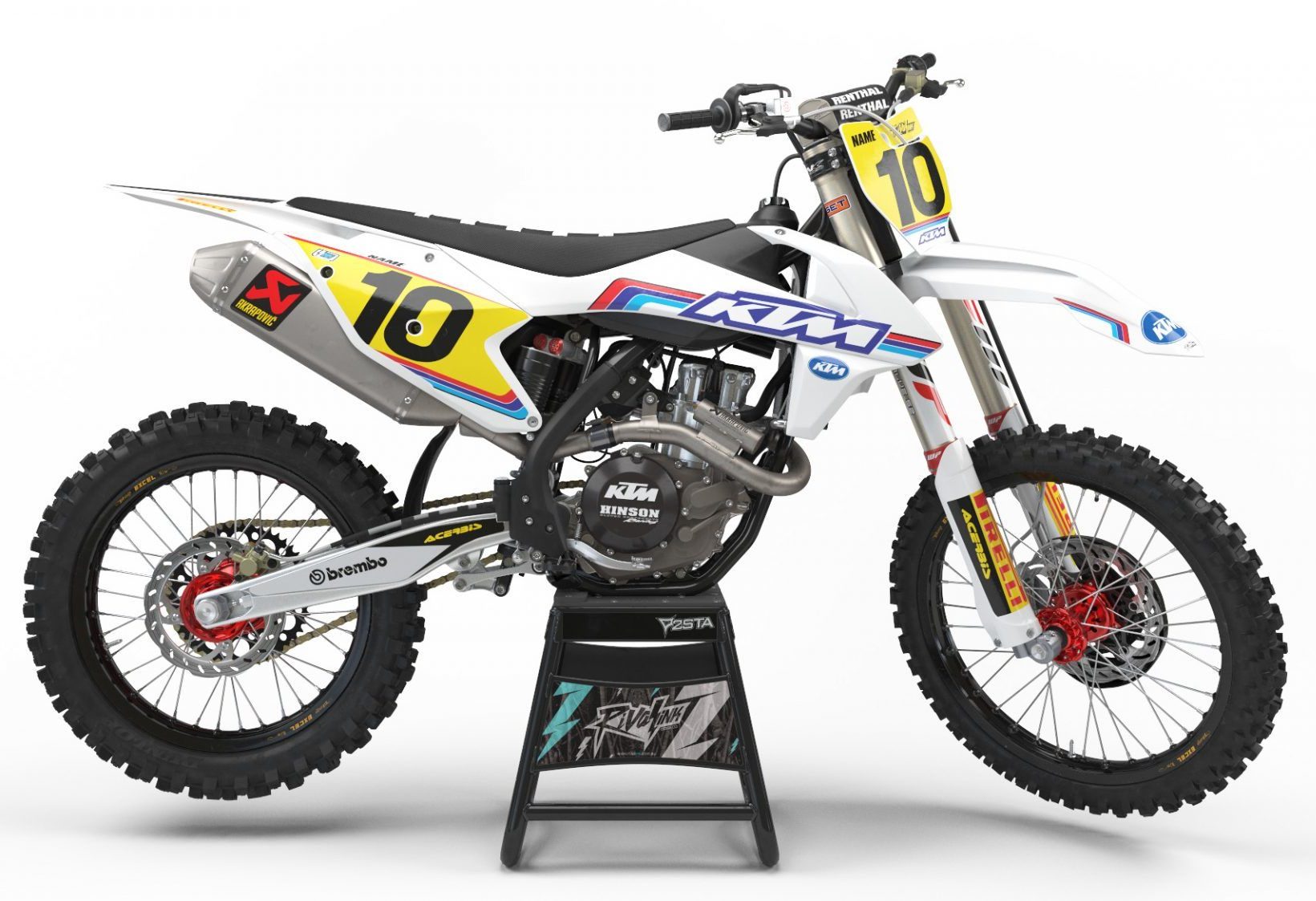A Deep Dive into KTM Retro graphics: A Blast from the Past
KTM, the Austrian motorcycle giant, has a rich and storied history, particularly in the realm of off-road and motocross. A significant part of that history is visually represented through their iconic graphics. These designs, often bold and vibrant, have not only adorned their bikes but have also become symbols of a specific era, evoking nostalgia among enthusiasts. Let’s delve into the fascinating world of KTM retro graphics, exploring their evolution, key elements, and enduring appeal.
The Early Days: Simplicity and Functionality
In the early years, KTM’s focus was primarily on functionality and performance. Graphics were relatively simple, often consisting of the brand name and perhaps a basic color scheme. These early designs prioritized clarity and visibility over elaborate aesthetics. Think clean lines, bold lettering, and a focus on making the bike easily identifiable on the track. This pragmatic approach reflected the brand’s commitment to performance and practicality.

The Rise of Color: The 70s and 80s
The 1970s and 80s witnessed a significant shift in motorcycle design, with bolder colors and more expressive graphics becoming increasingly popular. KTM embraced this trend, introducing vibrant hues like orange, yellow, and blue. These colors weren’t just chosen arbitrarily; they often reflected the national colors of Austria or were inspired by the racing scene. This era also saw the introduction of more complex geometric shapes and patterns, adding a dynamic visual element to the bikes. The “flying K” logo, a stylized KTM logo, also became a prominent feature, further solidifying the brand’s identity.
The Iconic Orange: A Defining Trait
Orange quickly became synonymous with KTM. While other manufacturers experimented with different colors, KTM doubled down on orange, making it their signature color. This strategic move helped establish a strong brand identity and made KTM bikes instantly recognizable on the track and on the street. The vibrant orange not only stood out visually but also conveyed a sense of energy and dynamism, reflecting the performance-oriented nature of the brand.

The 90s and Beyond: Evolution and Refinement
The 1990s and subsequent decades saw KTM continue to refine their graphic design language. While orange remained the dominant color, other hues were incorporated to create visual contrast and add depth to the designs. Geometric shapes became more intricate, and the use of gradients and shading added a three-dimensional feel to the graphics. The “Ready to Race” slogan, which encapsulates KTM’s competitive spirit, also began to feature prominently in their branding and graphics.
The Influence of Motocross: A Racing Heritage
KTM’s strong presence in motocross has significantly influenced their graphic design. The aggressive lines, bold colors, and dynamic shapes found on their motocross bikes often trickled down to their other models, including enduro and adventure bikes. This close connection between racing and design has helped create a cohesive brand identity and has reinforced KTM’s image as a high-performance motorcycle manufacturer.
The Revival of Retro: A Nostalgic Trend
In recent years, there has been a growing trend of manufacturers revisiting their past and incorporating retro design elements into their new models. KTM has also embraced this trend, offering special edition bikes with graphics inspired by their classic models. These retro-themed bikes have proven to be incredibly popular among enthusiasts, tapping into a sense of nostalgia and celebrating KTM’s rich history.
Key Elements of KTM Retro Graphics:
Bold Colors: Orange, yellow, blue, and white are some of the key colors that have defined KTM’s retro graphics.
The Enduring Appeal of Retro Graphics:
The enduring appeal of KTM retro graphics can be attributed to several factors:
Nostalgia: For many riders, these graphics evoke memories of their youth and the bikes they grew up admiring.
Recreating the Look: Aftermarket Options
For those who own older KTMs or want to add a retro touch to their newer models, a variety of aftermarket options are available. Decal kits, seat covers, and other accessories can be used to recreate the look of classic KTMs. These aftermarket options allow riders to personalize their bikes and express their appreciation for KTM’s design heritage.
The Future of KTM Graphics: Balancing Heritage and Innovation
As KTM continues to evolve, the challenge lies in balancing their rich design heritage with the need to innovate and stay relevant in a rapidly changing market. While retro-inspired designs will likely continue to be popular, KTM will also need to explore new graphic languages and aesthetics to appeal to future generations of riders. The key will be to maintain the brand’s core identity while embracing new technologies and design trends.
Conclusion: A Legacy of Style and Performance
KTM’s retro graphics are more than just visual adornments; they are a reflection of the brand’s history, values, and racing spirit. From the simple designs of the early years to the bold and vibrant graphics of the 70s and 80s, KTM’s visual language has evolved over time, but the brand’s commitment to performance and innovation has remained constant. As KTM continues to push the boundaries of motorcycle design, their retro graphics will undoubtedly continue to inspire and captivate riders for generations to come. They serve as a reminder of KTM’s legacy and a testament to the enduring power of good design.
ktm retro graphics
